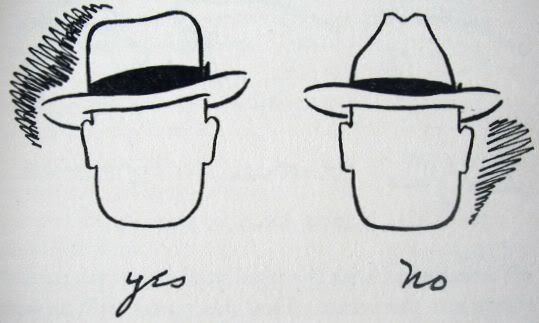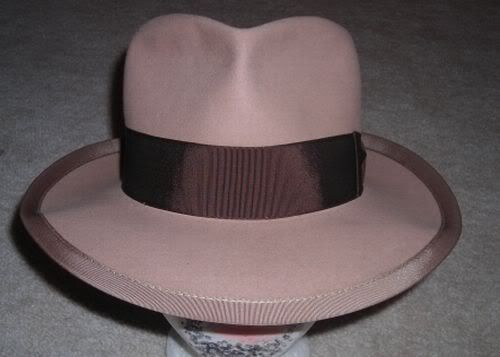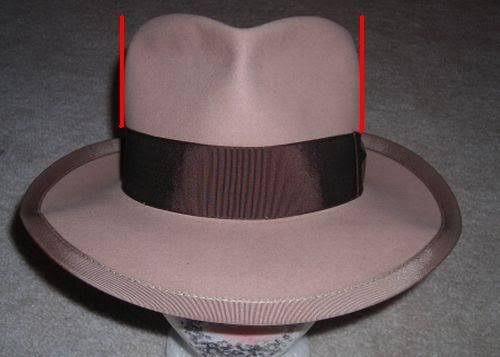After much delay and preparation I can now answer his question.
But where to start? Like most things in the world, this topic has hundreds if not thousands of details that could be explored. I think for now we'll just get into the basics.
So we'll start at the beginning. The first thing to decide is what kind of hat you would like to get. A fedora? Homburg? Maybe a classic Boater? Panama? Perhaps a Derby? Each one has it's own time and place.
The fedora is the most readily available and most useful since it can be worn to both casual and semi-formal events in weather warm and cold, wet and dry. Homburgs and derbies are more formal. Boaters can also be casual or formal, though they are only worn during warm weather, just like the Panama.
We'll stick with the fedora in this post.
Alrighty, so you're looking for a fedora. You can go modern or vintage (vintage being pre-1970, modern being post-1970). The rule of thumb is that construction material of vintage hats will be superior to that of modern hats. It is widely accepted by hat enthusiasts that the last year of high-quality fur felt was 1968. After 1968 the quality of the felt began to decline and the affects can be seen today.
Why the decline in quality after 1968?
New laws and regulations restricted manufacturing processes, thereby hurting the quality. Before 1968 the felt-making process used many harmful chemicals like mercury to plump and thicken the fur, making it dense and soft. Today since that process is no longer used hatters must make the felt thicker and use more chemical stiffener to make up for the difference. Hence the usual poor quality felt found today.
So, when looking at felt quality always remember that vintage beats modern nearly all the time. Of course, there are also fedoras made of wool felt, but wool is even worse quality than fur felt. Wool hats are alright and make fine, usually cheap beginner hats but don't last as long, wear as well or look as nice as fur felt.
I prefer vintage.
It's good to know your hat size, too. Click here to find your hat size.
Now, you're looking for a vintage fedora. What style? Again, there are thousands of styles and it can be difficult to choose. The style needs to match your face and you must like it.
 Click here to visit a website that will help you find a style that matches your head shape. Of course, the best way to find the right style is to go out and try on some hats! Look at yourself in a mirror and decide which hat looks best on your head. Ask others what they think. Shop around. Investigate.
Click here to visit a website that will help you find a style that matches your head shape. Of course, the best way to find the right style is to go out and try on some hats! Look at yourself in a mirror and decide which hat looks best on your head. Ask others what they think. Shop around. Investigate. And to help you understand some of the different styles I'll go into a few details, though not too many at first. I've thrown a lot at you already.
First we'll look at the crown. You know, the top part of the hat that encloses your head.
Each crown has a certain amount of taper to it. Taper is much (or how little) the sides of the crown lean in towards the middle. Below is an example of a fedora from the 1960s. Look at the bottom of the ribbon where the crown meets the brim and slowly move your eyes upward. Notice how the crown gets narrower as you eyes move towards the top of the crown. This hat has a lot of crown taper. This was the style beginning in the 1960s.

Another way to measure crown taper is to draw two lines along the sides of the crown. This shows the taper very well.

Now look at this hat from the 1940s.  Note that it has a taller crown than the 1960s hat above and it has no taper, perhaps even a bit of reverse taper (where the crown sides expand outward toward the top). This was the style from the 1920s-1950s.
Note that it has a taller crown than the 1960s hat above and it has no taper, perhaps even a bit of reverse taper (where the crown sides expand outward toward the top). This was the style from the 1920s-1950s.
 Note that it has a taller crown than the 1960s hat above and it has no taper, perhaps even a bit of reverse taper (where the crown sides expand outward toward the top). This was the style from the 1920s-1950s.
Note that it has a taller crown than the 1960s hat above and it has no taper, perhaps even a bit of reverse taper (where the crown sides expand outward toward the top). This was the style from the 1920s-1950s.
Hat's also have taper in the side profile. The late-1920s/early-1930s style hat below has neutral taper since the sides of the crown are perfectly vertical. Again, neutral taper was very common from the 1920s to the 1950s, specifically durin the 1920 and 1930s.

Brims, like crowns, changed quite a bit. Brims can be as narrow as 1" or as wide as 3". Hats with brims 2" wide or less are often called Stingy Brims. Stingies were the common style starting in the 1960s and are still popular today. Before the 1960s brims were wider. Classic brim widths from the 1930s were 2 1/4" and 2 1/2". During the 1940s they often went from 2 1/2" to 3" before slimming back down during the 1950s and entering the Stingy era of the 1960s.
------------
Here are the eras, beginning in the 1920s and ending with the 1960s, and the corresponding aspects of fedoras. Note that these were the most popular styles of the times and there are always exceptions to the rules.
*1920s
-Tall crowns with neutral or reverse taper. 4 1/2" or taller.
-Medium width brims. 2 1/4" to 2 1/2" wide.
*1930s
-Tall crowns with neutral or reverse taper. 4 1/2" or taller.
-Medium width brims. 2 1/4" to 2 1/2" brims were the rule until the late 1930s.
*1940s
-Tall to medium crowns with little to some taper. 4 1/4" to 5" tall.
-Medium to wide brims. 2 1/2" to 3".
*1950s
-Beginning to get lower with more taper. 4" to 4 1/2" tall.
-Beginning to get lower with more taper. 4" to 4 1/2" tall.
-Back to 1930s-style brim widths. 2 1/4" to 2 1/2" wide.
*1960s-today
-4" tall crown or less.
-2 1/4" wide brims or less.
Here are some good places to begin looking for modern fedoras:
High-quality custom-made fedoras:
Vintage hat and clothing forum, good for learning and fun to browse:
The best place to look for vintage hats is antique malls and shops. Not only are a lot of hats be priced less than $20 but you get to try them on, hold them and examine them.
Ebay is another place but expect to pay quite a bit for a good hat and you don't get to see it in person before you buy. There are also some sellers who aren't the greatest, so be careful and good luck.
This post is the first of who knows how many about what to look for in a hat. It'll take some times to explain this extensive topic so check back once in a while, I might have posted something new. There's a lot more to come.
Cheers.
2 comments:
Thank you so very much. Your post is very informative; talking to some hat aficionados in Atlanta yielded me similar advice. You definitely have given me some more to consider. So... for my first purchase I'm thinking a Grey fedora. I look forward to the additional installments. Thank you, again.
Thanks for your link to www.thefedorastore.com! I would be happy to post this blog on blog.thefedorastore.com if you like. Just email me with permission to ddewsbury@goldenwest.net. I will include attribution and a link to your blog.
Post a Comment